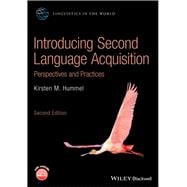An up-to-date overview of second language acquisition, designed to engage 21st-century learners
Introducing Second Language Acquisition: Perspectives and Practices provides a clear and comprehensive introduction to the main concepts, issues, and debates in second language acquisition studies. This introductory textbook is aimed specifically at students encountering the topic for the first time. Each chapter offers a modern layout with engaging pedagogical features such as self-assessment and discussion questions, project ideas, and further reading and viewing suggestions.
The second edition of Introducing Second Language Acquisition: Perspectives and Practices has been fully updated to reflect the most recent scholarship in the field. It introduces a new structure, featuring separate chapters on theoretical perspectives which cover past and present approaches as well as cognitive approaches. New content also includes sections on skill acquisition theory, translanguaging, second language literacy development, and multilingualism.
Written in accessible language and with a focus on practical applications, this go-to textbook is a clear and concise introduction to second language acquisition studies, offering lessons drawn from the latest leading research. It is an ideal resource for students in applied linguistics and second language education. This key text offers:
- Comprehensive coverage of the latest research in second language acquisition studies
- Improved organizational structure to promote greater student comprehension
- Engaging introduction to the theoretical underpinnings of second language acquisition, with chapters on first language acquisition and bilingualism and multilingualism
- Coverage of key topics including acquisition contexts, theoretical perspectives, language teaching methods, and individual differences
- Pedagogical tools to aid student learning, including “language learning in practice” textboxes, bolded terms defined in the margins, and an end-of-book glossary
With a strong focus on the fundamentals, this second edition of Introducing Second Language Acquisition stands as an innovative guide. This book is ideal for today’s undergraduate students, offering a practical focus and appealing format that will aid in learning and provide a solid foundation for further study.








